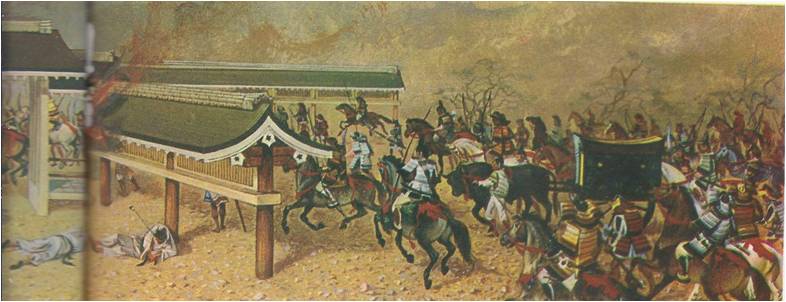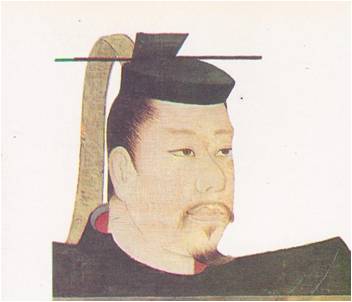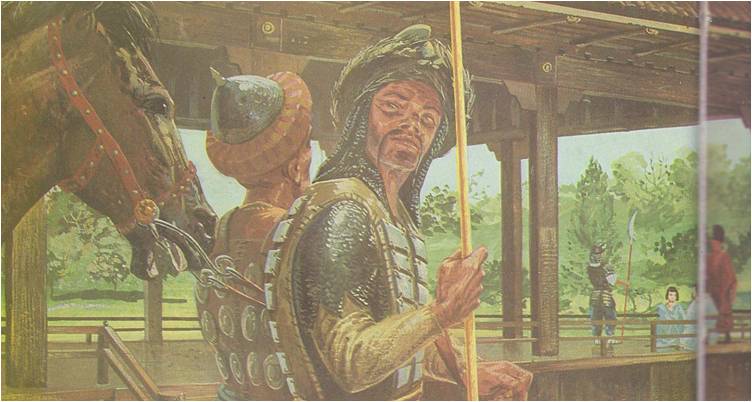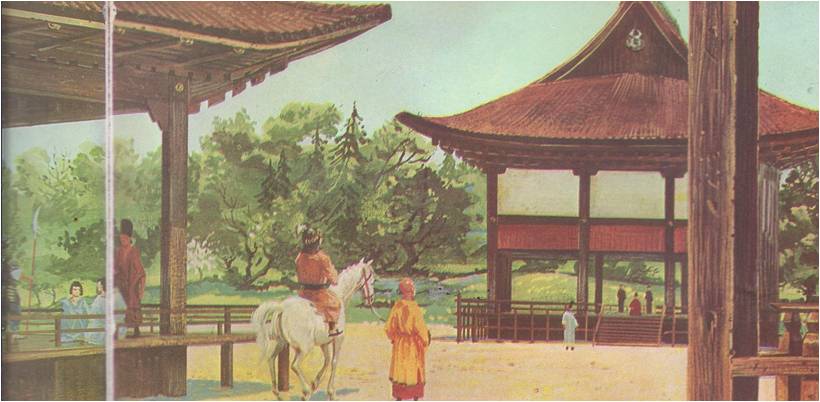BY THE middle of the twelfth century, Kyoto was no longer the real center of power in Japan. The old forms of government were kept unchanged. The emperor was still, supposedly, the source of all authority.
The aristocrats wanted to enjoy the excitement of the Fujiwara court and they left their poorer relatives at home to manage their estates. The young men who were given this responsibility did not mind. Indeed, they welcomed it, for it was their only chance to get rich. So the Japanese aristocracy was divided between great nobles at the court and lesser nobles in the country. While the great nobles led lives of pleasure, the lesser nobles led a more useful existence. At the court, what mattered was to wear the right clothes, to talk wittily and to invent clever verses. In the country, the main thing was to get as much rice as possible out of the land. To do this, the estate managers had to win the loyalty of their farmers.

Thus loyalty came to be the most honored of all virtues in rural Japan. Next to loyalty came bravery, for the estate managers often tried to add to their holdings by making war on their neighbours and their success depended on how bravely their men fought. The most important fighters wore armour and rode on horseback. They were much like the knights who were fighting in far-off Europe at that time. Japanese knights used bows and arrows and swords. Each knight was attended by a few followers on foot. He was called a samurai.
To the refined ladies and gentlemen of the court, the battles which raged in the countryside throughout the Fujiwara Period seemed too brutal and too far away for them to take any notice. They were in for a surprise. In 1156, two rival armies of knights clashed in Kyoto over the question of whether the emperor or his brother, the retired emperor, should reign. The leaders on the losing side were executed, for these country warriors were not Buddhists and saw nothing wrong in taking human life. In 1159 and 1160, the capital was again the scene of fighting. The winner, a man named Kiyomori, made himself the master of Kyoto. For the next twenty years he ruled the imperial court from his palace at the city’s edge.
Kiyomori’s party, which had armed followers all over Japan, was called the Taira. The party it had defeated was called the Minamoto. Minamoto strength was mainly on the Kanto Plain, east of Kyoto, where the modern Japanese capital, Tokyo, now stands. The Kanto Plain was much the largest area of flat land in Japan. It contained more and larger farms than any other area. The Minamoto leaders in their coastal headquarters town of Kamakura had plenty of men and money to draw on.

From 1180 to 1185, a bloody war raged between the rival parties. At last, the Minamoto warriors completely crushed their foes, and the victorious leader, Yorimoto, became the master of Japan. Instead of moving to Kyoto, Yorimoto stayed at Kamakura. Kamakura became the center of power, although Kyoto remained the capital.
Even though Yorimoto could now do whatever he liked, he was careful to get the Kyoto government‘s approval before he made any important move. For tradition meant as much to Yorimoto as it did to any Japanese. At last, in 1192, the emperor gave him the title Seii-tai-shogun, or “Barbarian-Quelling Generalissimo.” This meant that the imperial government recognized Yorimoto as the chief of a lawful military government. Japan was to have two rulers, an emperor and a shogun, for the next seven centuries.
EMPERORS AND SHOGUNS
It soon became clear that shoguns could be controlled just as emperors were. Yorimoto himself was mainly responsible for what happened to the shogun’s power. He was so afraid that his uncles and brothers were plotting against him that he either banished them or had them killed, one after another. When he died in 1199, he left only two male relatives, his two young sons. Before long, his widow and her father Tokimasa forced the elder son to resign as shogun. In 1203, Tokimasa adopted the title of shikken, or regent to the shogun. His sons and grandsons inherited the post. For the remainder of the Kamakura Period, Tokimasa’s family, the Hojo family, was the real power in Japan.

The Japanese had an enormous respect for tradition and wished to keep up appearances. The result, from 1203 to 1333, was a highly complicated situation. The ruler of Japan was supposedly the emperor. The emperor had lost control to a regent, who had lost control to a retired emperor, whose power had been taken by a shogun, who lost his power to a shikken.
The Hojo family ruled Japan firmly but fairly, through shoguns who were either Fujiwaras or members of the emperor’s family. In 1221 they easily put down a revolt started by a retired emperor. A far more serious threat came from abroad. In the second half of the thirteenth century, the country was in danger of being invaded for the first time in its history.
In 1266, Kublai Khan, the Mongol conqueror of the Southern Sung, began to send ambassadors to Japan with demands that the emperor pay him tribute. The Kyoto court was terrified, but the shogunal regent stood firm. Again and again he sent the ambassadors home empty-handed. At last Kublai lost his patience; in 1274 he sent twenty-five thousand Mongol and Korean troops against the islands. As they were coming ashore at Hakata Bay in North Kyushu, an army of Japanese warriors fell upon them and cut them to pieces. That night, the invaders who were still alive fled to sea in the midst of a howling storm.
THE CHINESE INVASION
Kublai was not discouraged. Again he demanded tribute from the Japanese. This time, instead of chasing the Mongol ambassadors away, the shogunal regent had their heads chopped off. Meanwhile, his subjects in North Kyushu were building a high wall around Hakata Bay. In 1281 Kublai sent a second force against the islands? Made up of 140,000 Mongols, Chinese and Koreans, it was probably the largest overseas expeditionary force in history until modern times. The Japanese were ready for it. The wall around Hakata Bay kept the invaders penned up on a narrow strip of beach. Whenever they broke out, the Japanese archers simply picked them off, one at a time.

For two months this continued and then a typhoon struck. Much of the Mongol fleet was destroyed and many soldiers were left stranded on the shore, where the Japanese quickly put an end to them. Probably no more than half of Kublai’s enormous force ever got home.
By twice defeating one of the greatest conquerors in history, the Kamakura government showed how strong it could be in war. All its might could not keep the descendants of its founders, Yorimoto’s Samurai, from growing poor through lack of land and becoming dependent on the rich warlords who lent them money. Nor could it insure the loyalty of knights who were bound by oaths sworn many years before by their grandfathers and great-grandfathers.
The man who set in motion the events which were to destroy the shogunate was neither a knight‚ nor a warlord, nor a traitor in the shogun’s court. He was an emperor, the Emperor Go-Daigo. In 1331 a dispute arose over whether Go-Daigo’s son or a youth from another branch of the imperial family should follow him as emperor. The shogunate decided against Go-Daigo and tried to get him to resign. Instead, Go-Daigo started a rebellion against the shogunate.
Go-Daigo was captured and exiled to a remote island, but some powerful warlord brought him back. In 1333, the Kamakura general who had been sent to recapture Go-Daigo suddenly switched sides and took Kyoto for the emperor. Then, with the help of another turncoat general, he exterminated the Hojo family and seized the post of shogun. Three years later he turned against Go-Daigo. He took Kyoto again and set up an emperor from a rival branch in place of Go-Daigo, who had fled.
The name of this general, twice a deserter, was Ashikaga Takauji.





